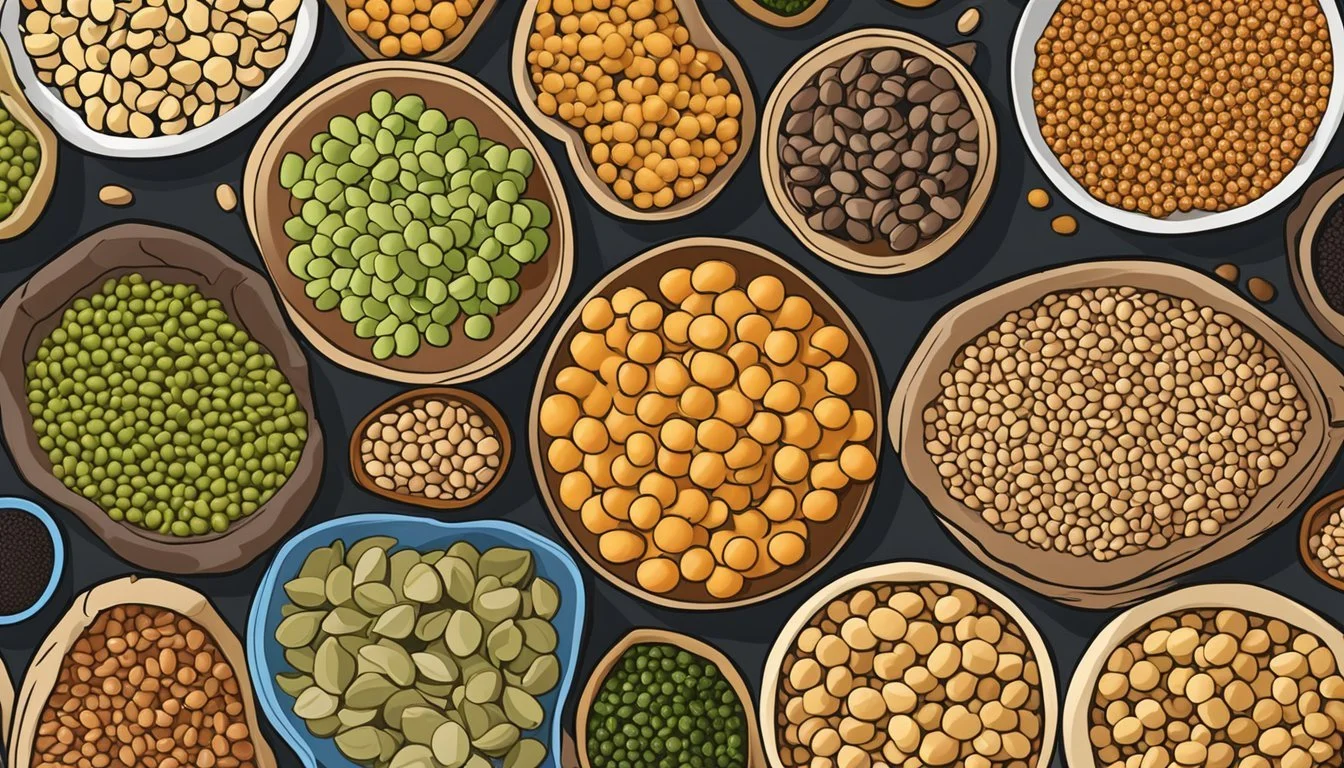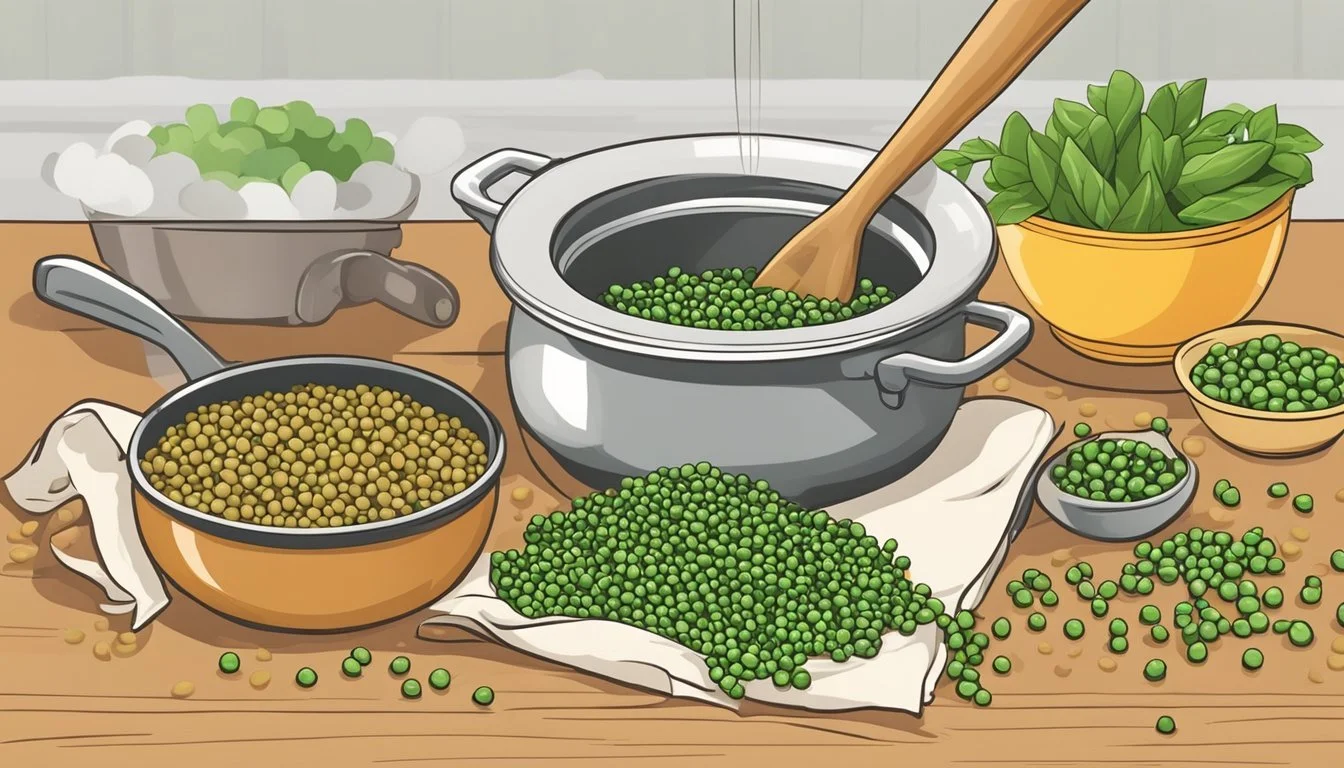Field Peas Substitutes
Best Alternatives for Cooking
Looking for a substitute for field peas? There are several excellent alternatives that can seamlessly fill their role in your recipes. Whether it’s the nutty black-eyed peas or the slightly sweet green beans, each substitute brings its own unique blend of nutrients, including protein, fiber, vitamins, and minerals.
Lima beans, for instance, make a great substitute and can add a creamy texture to any dish. Lentil beans, though tougher, are another versatile legume that can be used in place of field peas. They offer a robust nutritional profile, rich in protein and fiber, though they may require a longer cooking time.
Edamame is another superb option, providing a similar taste and texture to field peas. High in protein and fiber, edamame is a convenient alternative you can find in the frozen section of most grocery stores. Whether you choose black-eyed peas, lima beans, lentils, or edamame, you'll find these legumes are not only nutritious but versatile enough to enhance a variety of dishes.
Understanding Field Peas
Field peas, also known as Southern peas, are a type of legume notable for their diverse varieties, unique textures, and nutritional benefits. They come in various colors and provide essential proteins, fibers, and vitamins.
Characteristics of Field Peas
Field peas boast a spectrum of colors, from creamy white to light green. Their texture ranges from tender to firm, depending on the variety.
Lady peas are a popular type of field pea, known for their sweet flavor and tender texture. Unlike other types, lady peas produce a clear potlikker when cooked.
These legumes thrive in well-drained soil and full sun. It's advisable to plant them several weeks after the last frost. They require minimal feeding, making them a low-maintenance crop.
Nutritional Profile
Field peas are rich in protein, making them a valuable addition to many diets. An excellent source of fiber, they aid digestion and enhance satiety.
They also provide a range of vitamins and minerals, including vitamins A, C, and K, which are essential for overall health. These nutrients contribute to the immune system, skin health, and bone strength.
Moreover, their carbohydrate content is low, making them suitable for low-carb diets. Their versatility in culinary applications further enhances their appeal, from salads to hearty stews.
Culinary Uses of Field Peas
Field peas bring a distinct flavor to many dishes and can be a versatile ingredient in various cuisines. Their use spans traditional dishes and diverse cooking techniques, making them a staple in many kitchens.
Traditional Dishes
Field peas play a critical role in Southern cuisine. A popular dish is Hoppin’ John, a savory combination of field peas, rice, and sometimes ham hocks. This dish often appears at New Year celebrations for good luck.
Field peas are also center stage in Southern stews and soups. They shine when combined with aromatics like onions, garlic, and bell peppers, creating a hearty and flavorful base. These dishes may also incorporate smoked meats to enhance their rich taste.
Cooking Techniques
Cooking field peas often starts with soaking them, especially if they're dried. This step can reduce cooking time significantly. Once soaked, they can be simmered in water or broth.
To cook field peas without meat, using aromatics is essential. Combine them with onions, garlic, and celery for a depth of flavor. For a simple and nutritious side, field peas can be used in salads, paired with fresh herbs and vinaigrette.
Substitutes for Field Peas
Field peas can be swapped with other beans and vegetables that offer similar flavors and textures to suit various culinary needs. Each substitute has its unique properties, making them suitable for specific dishes like soups, stews, or side dishes.
Substitutes in Soups and Stews
In soups and stews, black-eyed peas are a fantastic option. They have a slightly nutty and earthy taste that complements the flavors typically found in these hearty dishes. Lentils are another good alternative due to their ease of cooking and ability to absorb flavors well. While they may take longer to soften compared to other substitutes, their texture and taste make them a suitable replacement.
Cranberry beans, known for their creamy texture, can also work well in soups and stews. They offer a mild and slightly nutty flavor, fitting perfectly into recipes that originally call for field peas. Navy beans contribute a smooth consistency and are known for their ability to blend seamlessly into various broth-based dishes.
Beans as Pea Alternatives
Green beans, often referred to as string beans, are crisp with a slightly sweet taste. They provide a similar texture to field peas, making them perfect for salads, stir-fries, and side dishes.
Lima beans also stand out as a substitute, particularly in dishes needing a rich and buttery texture. It's important to cook fresh lima beans thoroughly, as their raw form contains compounds that can be harmful.
Pinto beans deliver a creamy texture and slightly sweet flavor, making them suitable for a variety of recipes. Black beans add a dense, meaty texture, and their rich flavor makes them a fantastic addition to spicy or robust dishes that might otherwise utilize field peas.
Choosing the Right Substitute
When selecting a substitute for field peas, it's essential to consider both texture and flavor as well as nutritional content. Different legumes and vegetables can offer unique benefits and fit into various recipes seamlessly.
Considerations for Texture and Flavor
Field peas, including varieties such as Crowder peas and Purple Hull peas, have a distinct texture and earthy flavor. Alternatives like edamame provide a slightly crunchy texture, while lima beans offer a creamy consistency.
Fava beans can be an excellent substitute with their robust flavor and firm texture.
Green beans provide a crisp, sweet option and blend well in salads and stir-fries.
For a more southern twist, black-eyed peas and Crowder peas introduce a savory, nutty taste to dishes, suitable for rice and stews.
Nutritional Comparisons
Field peas are rich in fiber, protein, and essential vitamins and minerals. Substitutes should ideally match these nutritional benefits.
Edamame is high in protein and fiber, making it a nutritious alternative. Lima beans also provide excellent protein and fiber content along with essential vitamins.
Fava beans are packed with iron and magnesium, supporting overall health.
Green beans may not match the protein content but are a good source of vitamins A, C, and K.
Choosing the right substitute ensures that the dish retains its nutritional value and flavor profile while accommodating availability or dietary preferences.
Incorporating Substitutes into Dishes
When using substitutes for field peas in various recipes, it's essential to consider regional flavors and texture adjustments. This ensures the substitute blends seamlessly into the dish while maintaining its unique characteristics.
Tweaks for Regional Recipes
Different cuisines demand specific flavors that substitutes should align with. In Southern cuisine, black-eyed peas can replace field peas. They absorb flavors well, especially in dishes with chicken broth. When making a traditional recipe, be mindful of the soaking and simmer times, often required for dried beans.
In Asian cuisine, green peas or even chickpeas can be great alternatives in stir-fries. Their texture and slight sweetness work well with soy sauce-based dishes. Ensure they are cooked thoroughly but maintain a slight crunch.
For salads and dips, English peas can be used. Their bright, fresh taste and tender texture are suitable in cold dishes. They also pair well with acidic vinaigrettes or creamy dips, adding a vibrant color and subtle flavor.
Adjustments for Texture
Texture plays a critical role in dish satisfaction. Black-eyed peas should be slightly firm but cooked enough to be creamy inside. This consistency is important for rice dishes and stews, enhancing the overall mouthfeel.
English peas are often softer and can become mushy if overcooked. When using them in salads or stir-fries, it's best to blanch them quickly in boiling water, then cool them in ice water. This method preserves their crunch and bright color.
When substituting in soups and stews, ensure the substitute maintains its form. Overcooked peas can disintegrate, altering the dish's consistency. Adjust cooking times accordingly, especially if using canned alternatives, which generally need less cooking time than dried beans.
Preserving and Storing Substitutes
Proper storage of field pea substitutes ensures their quality and longevity. Effective techniques for preserving substitutes include freezing and drying methods that help maintain nutritional value and flavor.
Freezing and Thawing Techniques
Freezing is an efficient method for preserving field pea substitutes like green peas and black-eyed peas. Blanch them in boiling water for 2-3 minutes to halt enzyme activity. Transfer the blanched peas into an airtight container or plastic bag. Store in the freezer for up to 8 months.
To thaw frozen peas, place them in the refrigerator overnight or use a microwave on a defrost setting. Avoid refreezing previously thawed peas to maintain their texture and taste. Blanching and proper packaging are crucial steps to prevent freezer burn and nutrient loss.
Drying and Rehydrating
Drying field pea substitutes like yellow split peas increases their shelf life significantly. Spread cleaned peas on a drying tray and dry them in a dehydrator or an oven set to a low temperature (around 140°F/60°C) until they are brittle.
Rehydrating dried peas requires soaking them in water. Place the dried peas in a bowl and cover with water, letting them soak for several hours or overnight. This step ensures they reabsorb enough moisture to cook properly. Proper drying and rehydrating techniques preserve the nutritional benefits and flavor of the peas.
Health and Dietary Considerations
Field pea substitutes offer multiple health benefits and must accommodate various dietary needs. Key considerations include the nutritional advantages and potential allergens or intolerances related to legume-based diets.
Benefits of Legume-Based Diets
Legumes are renowned for their high Protein and Fiber content. Edamame and lima beans, which are popular field pea substitutes, provide excellent sources of plant-based Protein, benefiting vegetarian diets. Lima beans, for example, deliver a buttery texture while adding significant Fiber to the diet, promoting digestive health.
These substitutes also supply important micronutrients like iron, magnesium, and folate. Black-eyed peas, another viable substitute, are known for their nutty, earthy flavor and are rich in Proteins and dietary Fiber. This combination helps maintain balanced blood sugar levels and supports cardiovascular health.
Allergies and Intolerances
Although legumes are considered a Superfood, they can cause allergies or intolerances in some individuals. Common legume allergies often include lentils, peanuts, and soybeans. It is important for those with legume allergies to avoid substitutes like edamame (soybeans) and opt for hypoallergenic options such as sweet corn or zucchini.
For individuals sensitive to legume-based Pea Substitutes, a gradual introduction into the diet may help monitor any adverse effects. Always consult with a healthcare provider if uncertain about dietary restrictions or allergies related to legumes.
By understanding these health and dietary considerations, individuals can make informed choices that align with their nutritional needs and health goals.







